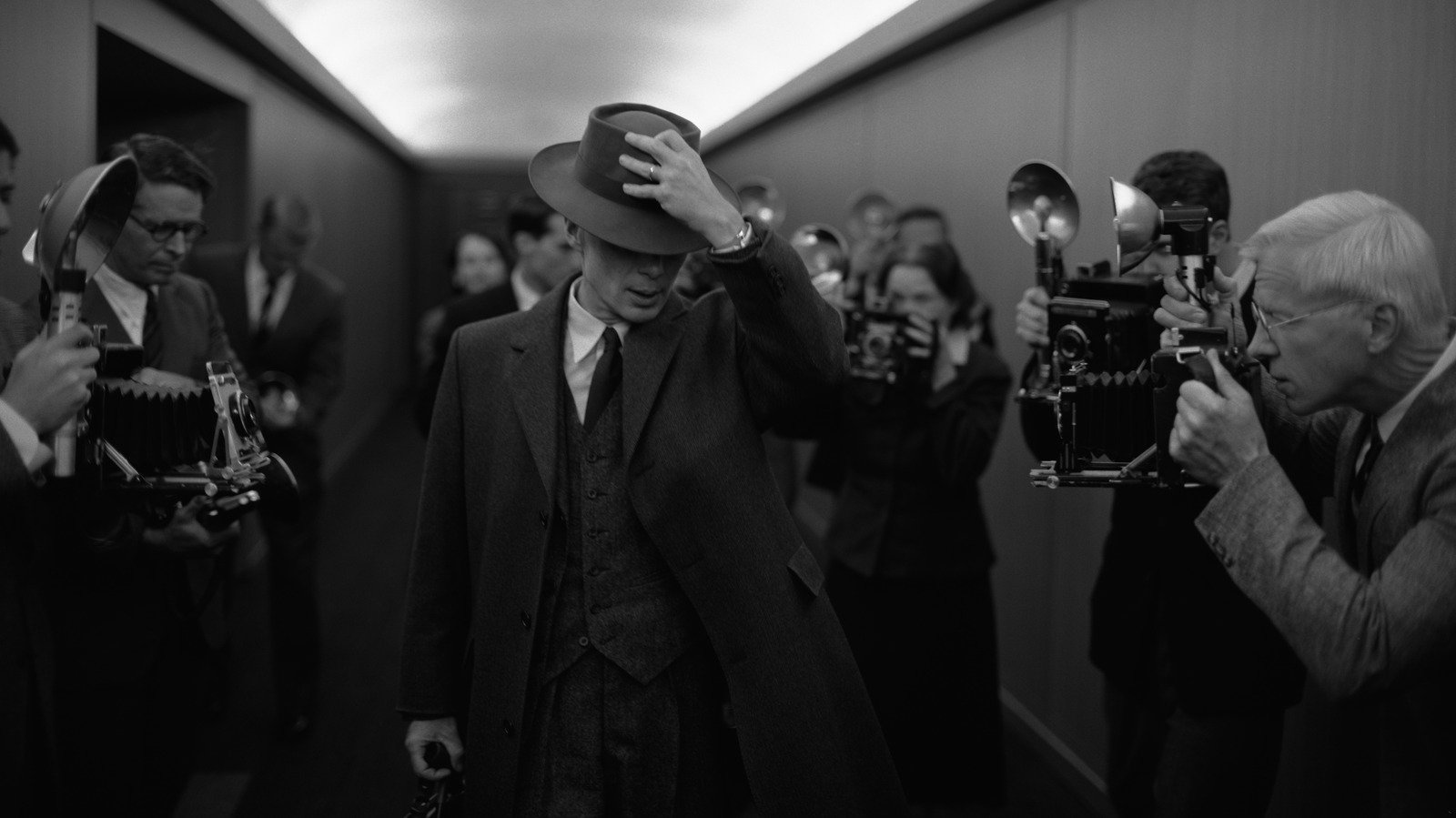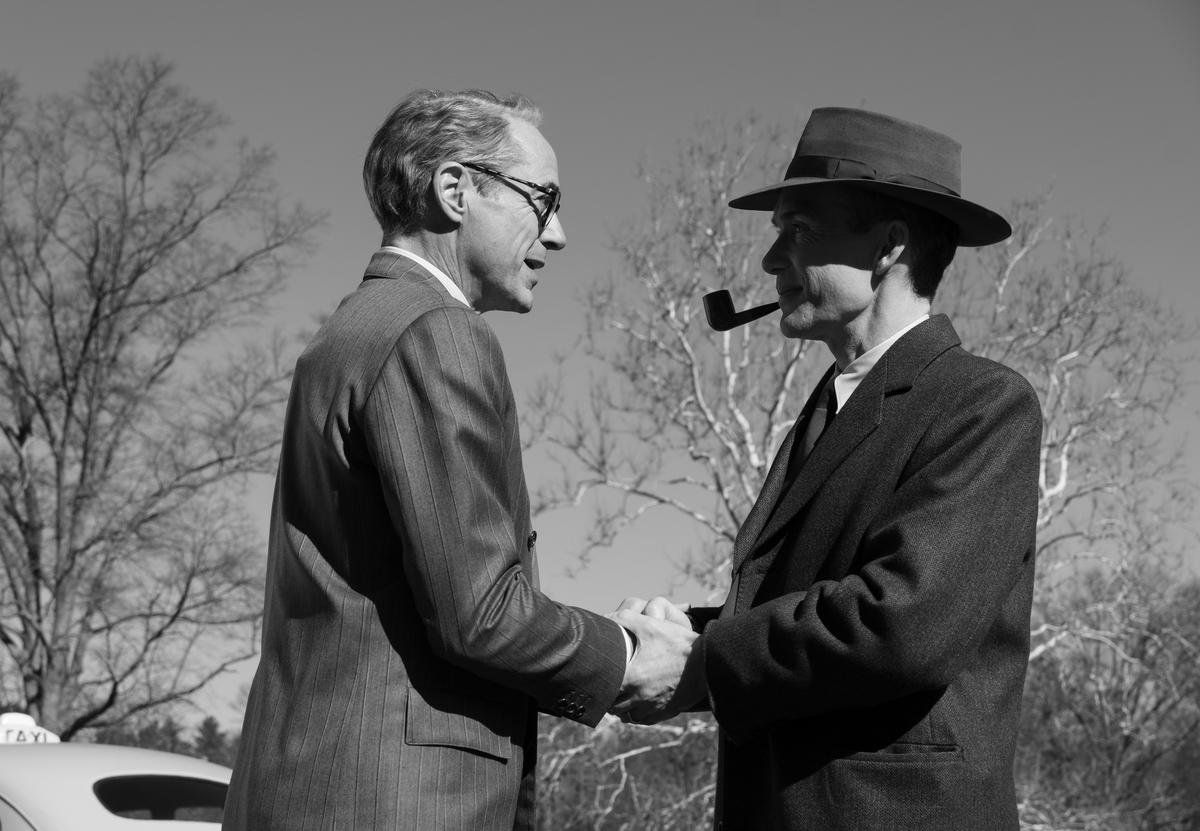“Oppenheimer” Review
Cillian Murphy astounds as Dr. J. Robert Oppenheimer, the father of the atomic bomb, in Christopher Nolan’s $100 million blockbuster “Oppenheimer.”
I have had the pleasure of seeing Christopher Nolan’s last three films (“Interstellar,” “Dunkirk” and “Tenet”) where they deserve to be experienced: in a movie theater. Nolan is one of those filmmakers that the average person knows on the same level as Spielberg or Tarantino. This is because Nolan is a director whose films each feel like a big event when they’re released and audiences know what they can get from his work. With Nolan, you’re going to get a massive spectacle, the likes of which you’ve never seen before and his films forgo simplistic CGI and mindless fun for practical visuals and a deeply philosophical plot. “Oppenheimer” is not only one of the finest films you can possibly see this year, but it feels like something Nolan has been wanting to make his whole life, resulting in his best film since “The Dark Knight.”
Based on the life of scientist J. Robert Oppenheimer (Cillian Murphy), the film details how the physicist came to be the head of the Manhattan Project and, with a slew of the world’s most brilliant scientific minds, created the atomic bomb. However, the choices Oppenheimer made in his personal life and as the head of the project cost him dearly and the film addresses the fallout of his life post-WWII as well as the emotional guilt that his creation gave him. Through this complex study Nolan asks us to do something that seems impossible: try to understand one of the most complex figures of the 20th century.
So much of what makes this film powerful may lie behind the camera but “Oppenheimer” truly belongs to one man: Cillian Murphy. While Murphy has worked with Nolan in supporting roles ever since “Batman Begins,” this is his first time in a leading role under the director and he is captivating from beginning to end. Murphy’s layered performance is the stuff dreams are made of. Every time you look into his eyes, you can just feel the gears in his head rapidly turning as well as his emotional disconnect from most people. But above all else, you perfectly perceive his love for the inner workings of the universe. Oppenheimer may not understand people, but he knows physics and his knowledge both astounds and horrifies us as we see just what it’s capable of.
As far as ensemble casts go, this is one of the largest and most impressive that I’ve seen in years. With a gigantic roster including Matt Damon, Florence Pugh, Benny Safdie, Kenneth Branagh, Jack Quaid, Josh Peck, Josh Hartnett, Dane DeHaan, Alex Wolff, Mathew Modine, Casey Affleck and so many more, it’s amazing how many big names wanted to be in “Oppenheimer,” even if just for a handful of scenes. One particular role that floored me in both its brevity and its effectiveness was Gary Oldman’s chilling performance as President Harry S. Truman.
Despite this massive quantity of legends, Nolan never abuses this by showing off his cast. Many of these people are introduced in an unassuming way and it’s not until a second or even third glance that you realize that Hughie from “The Boys” is playing future Nobel Prize winner Richard Feynman. Nolan takes a star-studded cast and strips them of any A-list star quality.
Just when you think that a certain star doesn’t really have that much to do in this film, they’ll floor you with a dramatic burst of energy. Rami Malek, Florence Pugh, Kenneth Branagh and Benny Safdie all get powerful moments that showcase their immense talent as actors. Emily Blunt in particular has an amazing turn as Kitty Oppenheimer during a hearing, going from just Oppenheimer’s wife to one of the biggest dramatic powerhouses in the entire film.
Writer/director Christopher Nolan (Left) crafts a magnificent opus utilizing the finest filmmaking minds and technology. His work is a testament to what cinema is capable of.
But out of the entire cast, it’s Robert Downey Jr. as Lewis Strauss that commands just as much power as Cillian Murphy. While Strauss and Oppenheimer didn’t meet until after the war, with Strauss becoming chair of the Atomic Energy Commission, Strauss becomes the physicist’s biggest threat and their feud during the McCarthy era of Communist witch hunts becomes one of the film’s central conflicts. Downey Jr. is outstanding and, while Murphy is a shoe-in for an Oscar nomination Best Actor, I hope that Downey Jr. gets nominated for Best Supporting Actor.
As the film’s director and writer, Nolan makes some daring choices with how he chose to tell this particular story. For starters, the story is told completely out of order and the screenplay was written from the first-person perspective of Oppenheimer. When Nolan translates this to the big screen, it’s done in the meticulous manner you’d expect with some incredible surprises. Whenever we are seeing a scene from Oppenheimer’s perspective, the film stock will be in color but, when he’s not the central character, the film’s color is left behind for black-and-white photography. This causes you to pay attention to how certain scenes play out, especially when Oppenheimer doesn’t have control. While it may be initially confusing for some to see this story’s timeline scattered all over the place, you certainly get used to it quickly and Nolan more than justifies his non-chronological storytelling, especially with the film’s final scene.
Everything about this film is committed to spectacle. Movies don’t need gigantic action sequences or a multitude of explosions to be epic, they just need to be told on a massive, practical scale using all the tools a filmmaker can muster. After dazzling audiences with his amazing day-for-night style of cinematography on “Nope,” director of photography Hoyte van Hoytema continues to prove himself a master behind the camera. The way this film is shot, particular the black-and-white sequences, feels very much like a documentary with a lot of hand-held work and a strong sense of presence. “Oppenheimer” doesn't want you to be an onlooker, it wants you to be in the field with these people, making these weapons and feeling this immense fear of the Nazis’ race to make their bomb, the terrifying weapons we’re going to make abd our own government targeting its own citizens during the Red Scare.
While seeing all of these big name stars being shot like important historical figures is visually stunning, most people who go into this film are going to want to know how the incredible explosions of atomic weapons are going to look. The detonation of the first atomic bomb, in the middle of the New Mexico desert, is one of the most impactful explosions I’ve seen in a long time. This is due to Nolan’s insistence that as much of the film’s special effects be done practically, as opposed to computers, and you feel that realism. While I’m sure some digital effects were utilized, they’re so seamlessly integrated with practical effects that it enhances the film, instead of being a distraction.
Robert Downey Jr.’s (Left) remarkable performance as Lewis Strauss is one of the best in the film and makes him an exceptional foe to the genius of Oppenheimer.
Unlike a movie like “Transformers: Rise of the Beasts,” you feel the weight of this fireball and the sound design is incredible. When the explosion first appears, there’s a thirty second period of pure silence until the sound wave meets the scientists in their bunkers and, during that period, I heard the packed theater collectively gasp at this visual marvel. When the sound wave finally met us, the sound was so loud that it physically shook me in my seat. It was one of the most immersive experiences of my entire cinematic life. The film’s gigantic score, composed by the incredible Ludwig Göransson, further cements this film’s ability to be effective visually and audibly with a hauntingly beautiful orchestral sound.
Given that this film has been released in July, it’s still unclear how the film will fare come awards season. I’m not sure if Nolan is going to win Best Director or if the film will win Best Picture (although it certainly has an incredibly strong chance) but I know one thing for sure. Jennifer Lame absolutely deserves an Academy Award for Best Film Editing for her truly remarkable job with “Oppenheimer.” With a runtime of three hours exactly, this seems like a daunting film for the average filmgoer to consume. However, as I have kept insisting, the length of a film doesn’t matter at all. It’s all about the pacing. There is not one boring moment in “Oppenheimer.” To be honest, the film felt like two hours instead of three. I have no idea where that extra hour went but that’s a testament to Lame’s skills as an editor. Verna Fields would be congratulating her for her efforts.
While the film is set in the 1940s and 50s, the issues that “Oppenheimer” brings up concerning scientific innovation and how we use it are still very much relevant. Nuclear weapons and their use have been an ethical dilemma humanity has been forced to confront for nearly 80 years and “Oppenheimer” addresses just how much the titular man struggled with his own guilt over his creation. The film may be a massive spectacle, but it never loses sight of Dr. Oppenheimer, his feelings and his work. It’s the kind of character study that fascinates me and makes me want to read as many books as possible about these people and their work. I feel that people are going to look at Oppenheimer the same way that people look at the titular WWII general in “Patton.” Some people can watch the film and love the man, others can despise him and some may find themselves unsure of how to feel. None of these perspectives are necessarily wrong but it does show how well the film depicts the complexities of this enigmatic mind.
What Nolan has accomplished is truly outstanding and “Oppenheimer” feels like a film that shouldn’t exist. It’s a three-hour long character study that was shot on IMAX film with numerous sequences in black-and-white and no violence aside from a few detonations of these incredible bombs. Only a filmmaker of Nolan’s caliber could demand this much of a studio and get his way which is why we’re all fortunate that he’s out there making these kinds of films. Christpher Nolan’s next one can’t come soon enough.




